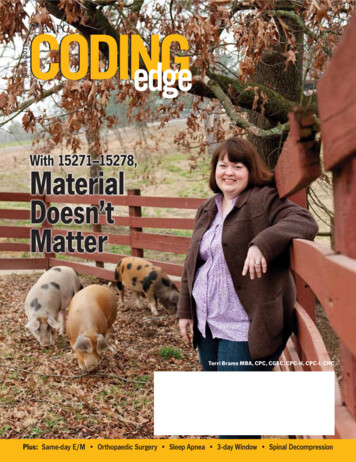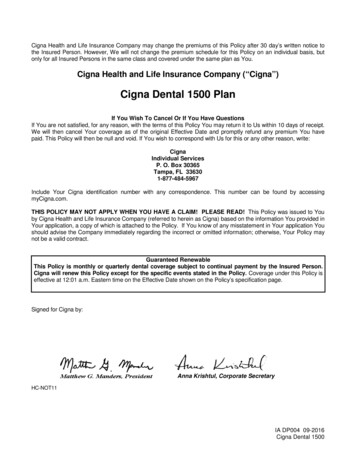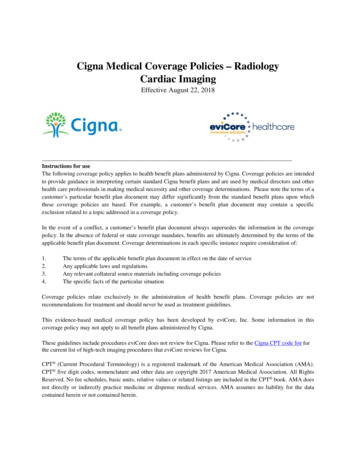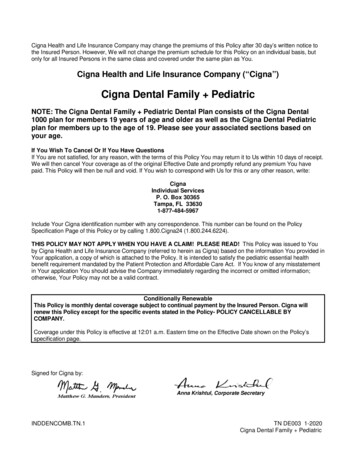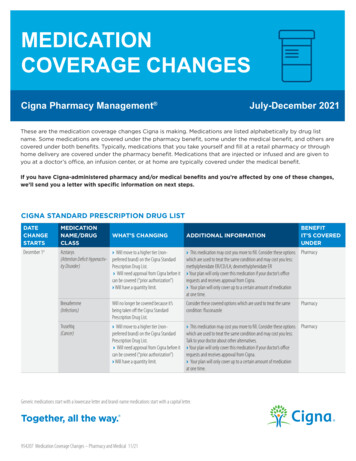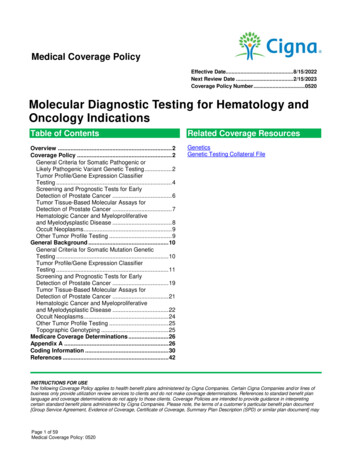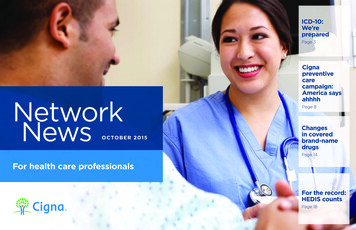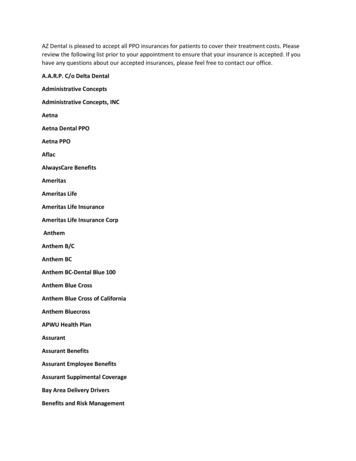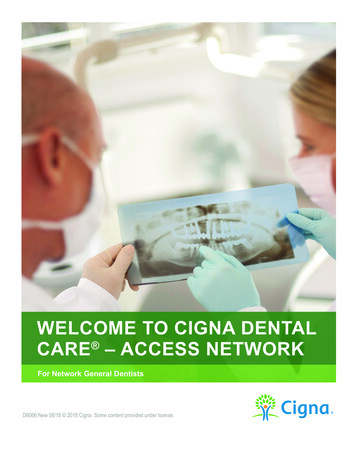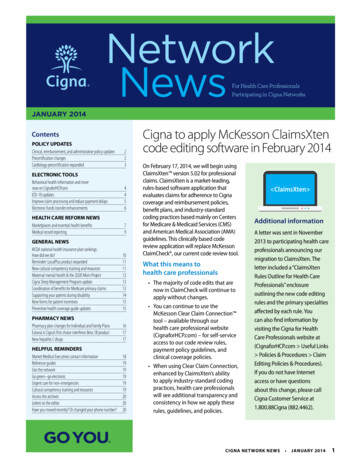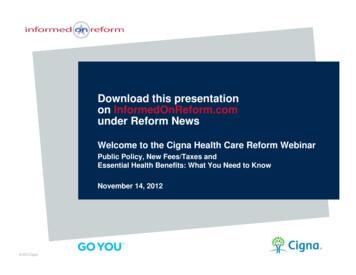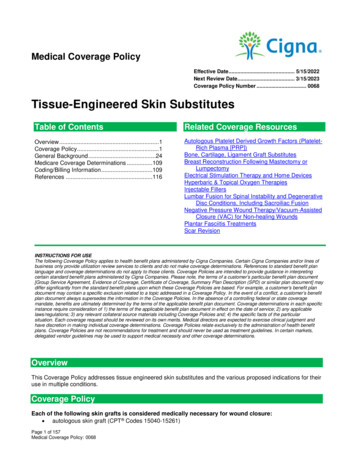
Transcription
Cigna Medical Coverage PolicySubjectTissue-Engineered SkinSubstitutesTable of ContentsCoverage Policy . 1General Background . 12Coding/Billing Information . 45References . 62Effective Date . 9/15/2014Next Review Date .9/15/2015Coverage Policy Number . 0068Hyperlink to Related Coverage PoliciesAllograft Transplantation of the KneeAutologous Platelet Derived Growth Factors(Platelet-Rich Plasma [PRP]) Becaplermin (Regranex )Bone Graft Substitutes for Use in BoneRepairBreast Reconstruction FollowingMastectomy or LumpectomyElectrical Stimulation Therapy and DevicesHyperbaric Oxygen Therapy, Systemic &TopicalLumbar Fusion for Spinal Instability andDegenerative Disc Conditions,Including Sacroiliac FusionNegative Pressure WoundTherapy/Vacuum-Assisted Closure(VAC) for Non-Healing WoundsPlantar Fasciitis TreatmentsPulsed Electromagnetic TherapyScar RevisionINSTRUCTIONS FOR USEThe following Coverage Policy applies to health benefit plans administered by Cigna companies. Coverage Policies are intended to provideguidance in interpreting certain standard Cigna benefit plans. Please note, the terms of a customer’s particular benefit plan document [GroupService Agreement, Evidence of Coverage, Certificate of Coverage, Summary Plan Description (SPD) or similar plan document] may differsignificantly from the standard benefit plans upon which these Coverage Policies are based. For example, a customer’s benefit plandocument may contain a specific exclusion related to a topic addressed in a Coverage Policy. In the event of a conflict, a customer’s benefitplan document always supersedes the information in the Coverage Policies. In the absence of a controlling federal or state coveragemandate, benefits are ultimately determined by the terms of the applicable benefit plan document. Coverage determinations in each specificinstance require consideration of 1) the terms of the applicable benefit plan document in effect on the date of service; 2) any applicablelaws/regulations; 3) any relevant collateral source materials including Coverage Policies and; 4) the specific facts of the particularsituation. Coverage Policies relate exclusively to the administration of health benefit plans. Coverage Policies are not recommendations fortreatment and should never be used as treatment guidelines. In certain markets, delegated vendor guidelines may be used to supportmedical necessity and other coverage determinations. Proprietary information of Cigna. Copyright 2014 CignaCoverage PolicyCigna covers each of the following as medically necessary for wound closure: autologous skin graft (CPT Codes 15040-15261) unprocessed allogeneic human, cadaver-derived skin graft (CPT Codes 15271-15278) unprocessed allogeneic pig skin derived skin graft (CPT Codes 15271-15278)Cigna covers each of the following products as indicated:Page 1 of 75Coverage Policy Number: 0068
Skin Substitute/Platelet DerivedGrowth Factor AlloDermCriteriaBreastreconstructionCovered as medically necessary whenused in association with a covered,medically necessary breastreconstruction procedureCovered as medically necessary whenused in association with a covered,medically necessary breastreconstruction procedureCovered as medically necessary whenALL of the following criteria are met: full-thickness diabetic foot ulcer ofgreater than three weeks durationfor which standard wound therapyhas failed type 1 or type 2 diabetes mellituswith a hemoglobin A1c (HbA1C)less than 12% treated foot has adequate bloodsupply as evidenced by either thepresence of a palpable pedal pulseor an ankle-brachial index (ABI) of 0.70 Breastreconstruction Diabetic footulcerAlloMaxApligrafIndicationApplication/CPT 115271-15274Q4101When the above medical necessitycriteria are met, the following conditionsof coverage apply: treatment is limited to one initialapplication additional applications at aminimum of one week intervals, forup to a maximum of four in 12weeks are considered medicallynecessary when evidence of woundhealing is present (e.g., signs ofepithelialization and reduction inulcer size)Apligraf Venous stasisulcerAdditional applications beyond 12weeks are considered not medicallynecessary regardless of wound status.Covered as medically necessary whenBOTH of the following criteria are met: partial- or full-thickness venousstasis ulcer of greater than fourweeks duration for which standardwound therapy has failed treated foot has adequate bloodsupply as evidenced by either thepresence of a palpable pedal pulseor an ankle-brachial index (ABI) of 0.70When the above medical necessitycriteria are met, the following conditionsof coverage apply:Page 2 of 75Coverage Policy Number: 0068
Skin Substitute/Platelet DerivedGrowth FactorIndicationCriteria BiobraneBurn woundBiobrane-LBurn woundDermagraft Diabetic footulcerApplication/CPT 50-15157C5271-C5278Q4100treatment is limited to one initialapplicationadditional applications at aminimum of one week intervals, forup to a maximum of four in 12weeks when evidence of woundhealing is present (e.g., signs ofepithelialization and reduction inulcer size)Additional applications beyond 12weeks are considered not medicallynecessary regardless of wound status.Covered as medically necessary whenused for temporary covering of a partialthickness freshly debrided or excisedburn woundCovered as medically necessary whenBOTH of the following criteria are met: temporary covering of a partialthickness freshly debrided orexcised burn wound adjunct to meshed autograftCovered as medically necessary whenALL of the following criteria are met: full-thickness diabetic foot ulcer ofgreater than six weeks duration forwhich standard therapy has failed type I or type II diabetes mellituswith a hemoglobin A1c (HbA1C)less than 12% treated foot has adequate bloodsupply as evidenced by either thepresence of a palpable pedal pulseor an ankle-brachial index (ABI) of 0.70When the above medical necessitycriteria are met, the following conditionsof coverage apply: treatment is limited to one initialapplication additional applications for up to amaximum of eight in 12 weekswhen there is evidence of woundhealing (e.g., signs ofepithelialization and reduction inulcer size)EpicelBurn woundPage 3 of 75Coverage Policy Number: 0068Additional applications beyond 12weeks are considered not medicallynecessary regardless of wound status.Covered as medically necessary whenused according to the U.S. Food and
Skin Substitute/Platelet DerivedGrowth Factor EpiFix AmnioticMembraneIndicationDiabetic footulcerCriteriaDrug Administration (FDA)-approvedHumanitarian Device Exemption (HDE)for an individual with deep dermal orfull-thickness burns comprising a totalbody surface area of greater than orequal to 30%Covered as medically necessary whenALL of the following criteria are met: partial or full-thickness, diabetic footulcer of greater than four weeksduration for which standard woundtherapy has failed type 1 or type 2 diabetes mellituswith a hemoglobin A1c (HbA1C)less than 12% treated foot has adequate bloodsupply as evidenced by either thepresence of a palpable pedal pulseor an ankle-brachial index (ABI) of 0.70Application/CPT 5274Q4131When the above medical necessitycriteria are met, the following conditionsof coverage apply: treatment is limited to one initialapplication additional applications may beapplied at a minimum of one weekintervals, for up to a maximum offour in 12 weeks are consideredmedically necessary when evidenceof wound healing is present (e.g.,signs of epithelialization andreduction in ulcer size) EpiFix AmnioticMembraneVenous stasisulcerAdditional applications beyond 12weeks are considered not medicallynecessary regardless of wound status.Covered as medically necessary whenBOTH of the following criteria are met: partial- or full-thickness venousstasis ulcer of greater than fourweeks duration for which standardwound therapy has failed treated foot has adequate bloodsupply as evidenced by either thepresence of a palpable pedal pulseor an ankle-brachial index (ABI) of 0.70When the above medical necessitycriteria are met, the following conditionsof coverage apply: treatment is limited to one initialapplicationPage 4 of 75Coverage Policy Number: 0068
Skin Substitute/Platelet DerivedGrowth FactorIndicationCriteria FlexHD AcellularHydrated Dermis GraftJacketRegenerativeTissue Matrix Integra etic footulcerBurn wound Integra BilayerMatrix WoundDressing Application/CPT 05additional applications at aminimum of one week intervals, forup to a maximum of four in 12weeks when evidence of woundhealing is present (e.g., signs ofepithelialization and reduction inulcer size)Additional applications beyond 12weeks are considered not medicallynecessary regardless of wound status.Covered as medically necessary whenused in association with a covered,medically necessary breastreconstruction procedure.Covered as medically necessary whenALL of the following criteria are met: partial or full-thickness, diabetic footulcer of greater than four weeksduration for which standard woundtherapy has failed type 1 or type 2 diabetes mellituswith a hemoglobin A1c (HbA1C)less than 12% treated foot has adequate bloodsupply as evidenced by either thepresence of a palpable pedal pulseor an ankle-brachial index (ABI) of 0.70When the above medical necessitycriteria are met, one application isconsidered medically necessary.Covered as medically necessary whenBOTH of the following criteria are met: postexcisional treatment of a fullthickness or deep partial-thicknessburn sufficient autograft is not availableat time of excision or iscontraindicatedQ4104Integra MatrixWound DressingQ4108 Integra MeshedBilayer WoundMatrix NeoForm Dermis Oasis WoundMatrixC9363BreastreconstructionDiabetic footulcer Oasis Ultra TriPage 5 of 75Coverage Policy Number: 0068Covered as medically necessary whenused in association with a covered,medically necessary breastreconstruction procedureCovered as medically necessary whenALL of the following criteria are met: partial or full-thickness, diabetic footulcer of greater than four 278C5275-C5278Q4102Q4124
Skin Substitute/Platelet DerivedGrowth FactorLayer MatrixIndicationCriteriaApplication/CPT HCPCSCodesProductHCPCSCodesCovered as medically necessary whenBOTH of the following criteria are met: partial or full-thickness, lowerextremity venous stasis ulcer of fourweeks duration for which standardwound therapy has failed treated foot has adequate bloodsupply as evidenced by either thepresence of a palpable pedal pulseor an ankle-brachial index (ABI) of 0.7015271-15274C5271-C5274Q4102Covered as medically necessary whenused in association with a covered,medically necessary breastreconstruction procedure.Covered as medically necessary whenALL of the following criteria are met: partial or full-thickness, diabetic footulcer of greater than four weeksduration for which standard woundtherapy has failed type 1 or type 2 diabetes mellituswith a hemoglobin A1c (HbA1C)less than 12% treated foot has adequate bloodsupply as evidenced by either thepresence of a palpable pedal pulseor an ankle-brachial index (ABI) of 278C5275-C5278Q4121 Oasis Wound Matrix Venous stasisulcerOasis Ultra TriLayer Matrix SurgiMend TheraSkinBreastreconstructionDiabetic footulcerduration for which standard woundtherapy has failedtype 1 or type 2 diabetes mellituswith a hemoglobin A1c (HbA1C)less than 12%treated foot has adequate bloodsupply as evidenced by either thepresence of a palpable pedal pulseor an ankle-brachial index (ABI) of 0.70When the above medical necessitycriteria are met, the following conditionsof coverage apply: treatment is limited to one initialapplication additional applications may beapplied at a minimum of one weekintervals, for up to a maximum offour in 12 weeks are consideredmedically necessary when evidenceof wound healing is present (e.g.,signs of epithelialization andPage 6 of 75Coverage Policy Number: 0068Q4124
Skin Substitute/Platelet DerivedGrowth FactorIndicationCriteriaApplication/CPT 412115271-15278C5271-C5278Q4100reduction in ulcer size) TheraSkinVenous stasisulcerAdditional applications beyond 12weeks are considered not medicallynecessary regardless of wound status.Covered as medically necessary whenBOTH of the following criteria are met: partial- or full-thickness venousstasis ulcer of greater than fourweeks duration for which standardwound therapy has failed treated foot has adequate bloodsupply as evidenced by either thepresence of a palpable pedal pulseor an ankle-brachial index (ABI) of 0.70When the above medical necessitycriteria are met, the following conditionsof coverage apply: treatment is limited to one initialapplication additional applications at aminimum of one week intervals, forup to a maximum of four in 12weeks when evidence of woundhealing is present (e.g., signs ofepithelialization and reduction inulcer size) TranscyteBurn woundAdditional applications beyond 12weeks are considered not medicallynecessary regardless of wound status.Covered as medically necessary whenused for temporary covering of asurgically excised deep partial- or fullthickness burn wound as a coveringprior to autografting.Cigna does not cover any of the products listed above for ANY unlisted indication because each isconsidered experimental, investigational, or unproven.Cigna does not cover ANY of the following products* because each is considered experimental,investigational, or unproven for ANY indication (this list may not be all-inclusive):Skin SubstituteAdherus Dural SealantAllopatch HD AlloSkinPage 7 of 75Coverage Policy Number: 0068Reason(s) for Request(this list may not be all inclusive)Dural repairTendon augmentationWound careApplication/CPT HCPCSCodesNo specificcodeNo Q4128Q4115
Skin SubstituteReason(s) for Request(this list may not be all inclusive) AlloSkin RTWound care AmnioCareTendon/nerve repair AmnioExCel/BioDExCelWound careSoft tissue repair Amniofix Amniotic MembraneAmnioMatrix Tendon/nerve repairWound careSoft tissue repairWound careSoft tissue repairWound careAmnioMTM InjectableArchitect BiomatrixApplication/CPT HCPCSCodesC52781527115278C5271C5278No specificcode1527115278C5271C5278No 23Q4100Q4137Q4100Q4139V2790Q4100 Surgical wrap/barrierTendon repair1527115278C5271C5278No specificcode1527115278C5271C5278No specificcode Surgical wrap/barrierTendon repairNo 00C1781Q4100Q4100 ArthroFlex (FlexGraft )BioDfactorShoulder reconstructionAchilles tendon repairWound careSoft tissue repair BioDfenceBioDfence DryFlex Biodesign (Surgisis ) AFP AnalFistula Plug Biodesign (Surgisis ) HiatalHernia Matrix Biodesign (Surgisis ) InguinalHernia Matrix Biodesign (Surgisis ) RVPRecto-Vaginal Fistula Plug BioVance Clarix Regenerative Matrix ConexaAnal and rectal fistula repairHernia repairHernia repairRecto-vaginal fístula repairWound CareSurgical covering/wrap/barrierTendon repair CorMatrix ECM for CardiacTissue Repair CorMatrix ECM for CarotidRepair CorMatrix ECM for PericardialPage 8 of 75Coverage Policy Number: 0068Intracardiac patchCarotid artery repairPericardial repairNo specificcodeNo specificcodeNo specificcode1527115278C5271C5278No specificcodeNo specificcodeNo specificcodeNo specificcodeNo 100
Skin SubstituteReason(s) for Request(this list may not be all inclusive)Closure CryoSkinWound care Cymetra DermacellIntegumental tissue repairWound careBreast reconstructionDermaMatrix Acellular DermisFacial soft tissue defectsBreast reconstruction DermaSpanDuraformWound coveringTendon repairDural repair DuraGenDural repairDuraGuardDural repairDuraMatrix Dural repair Dural repair Dural repairDuraSeal Dural Sealant SystemDuraSeal Spine Sealant SystemDurepair Regeneration MatrixEndoform Dermal Template Epifix InjectableExcellagen EZ Derm Dural repairWound careWound careWound CareWound careFloGraft TendonitesSoft tissue traumaGammaGraftWound care GORE BIO-A Fistula PlugAnorectal fistulasGrafix Core Wound Care Wound CareGrafix PrimePage 9 of 75Coverage Policy Number: 0068Application/CPT 77C5271C52781527115278157771527115278No specificcodeNo specificcodeNo specificcodeNo specificcodeNo specificcodeNo specificcodeNo 32Q4133
Skin SubstituteReason(s) for Request(this list may not be all inclusive) Wound careIntegumental tissue repair Wound careGraftJacket Xpress hMatrixHyalomatrix PA HydroFix Vaso Shield Vessel guardIntegra Flowable Wound Matrix MatriStemWound careWound careMatrix HD Wound careTendon repair MediskinWound careMemoDerm Wound careTendon repairWound care Neox Wound Matrix NeuraGen Nerve GuidePeripheral nerve repairNeuraWrap Nerve ProtectorPeripheral nerve repair NuCelTendon repair Tendon repair Dura repairNuShield OrthopaedicsNuShield Spine Burn wounds Burn woundsOasis Burn MatrixOrcel OrthADAPT Bioimplant OsseoGuard OvationPage 10 of 75Coverage Policy Number: 0068Soft tissue reinforcementOral defectsWound healingApplication/CPT HCPCSCodesN/A15271152781527115278C5271C5278No 15278C5271C527815271152781527115278C5271C5278No specificcodeNo specificcodeNo specificcodeNo specificcodeNo Q4100C1781Q4100Q4100Q4100
Skin Substitute Peri-Guard Repair Patch Peri-Strips Dry PermacolSoft tissue repairPericardial and intracardiac repairStaple line reinforcementSoft tissue reinforcement/repair Dural Repair Pericardial repair Wound carePreclude Dura SubstitutePreclude Pericardial MembranePriMatrixReason(s) for Request(this list may not be all inclusive) Reconstructive surgeryBreast reconstructionAbdominal wall repairRestore Orthobiologic Soft TissueImplant Seamguard Staple LineReinforcement SportMesh Soft tissue reinforcementSteriShield Soft tissue reinforcement/repairReprizaStaple line reinforcementSoft tissue reinforcement Soft tissue reinforcement/repair Wound careStrattice Reconstructive TissueMatrixTalymed TenoGlide Tendon ProtectorSheet TenSIXTendon repairTissueMendSoft tissue repairTendon repairSoft tissue reinforcement/repair Tornier BioFiber AbsorbableBiological Scaffold Tornier Collagen Coated BioFiberScaffold Unite Biomatrix Vascu-GuardPage 11 of 75Coverage Policy Number: 0068Wound careTendon repairSoft tissue reinforcement/repairWound carePeripheral vascular reconstructionApplication/CPT HCPCSCodesC52781527115278C5271C5278No specificcode152711527815777No specificcodeNo specificcode15271152781527115278C5271C527415777No 7115278No 78157771527115278157771527115278C5271C5278No 4100Q4129Q4100
Skin SubstituteReason(s) for Request(this list may not be all inclusive)Veritas Collagen MatrixSoft tissue reinforcement/repairVeritas Collagen Matrix Peri-StripsDryXCM Biologic Vascular PatchStaple line reinforcementSoft tissue reinforcement/repair Soft tissue reinforcement/repair Cardiac reconstruction/repairVascular reconstruction/repairXenMatrix Surgical GraftXenoSure Biologic Vascular PatchApplication/CPT HCPCSCodes152711527815777No 77C5271C5278No 1781Q4100C1781Q4100General BackgroundAutologous Skin Grafts and Cadaver-Derived Skin GraftsAutologous skin grafts and the use of fresh, unprocessed allogeneic cadaver-derived skin grafts are establishedprocedures for wound care. Autologous skin grafts, or autografts, refer to tissue transplanted from one location toanother in the same individual. Autografts are referred to as partial-thickness or split-thickness graft. Autograftsare ideal because there is no risk of rejection. In some cases, the area of healthy skin available for harvestingmay be inadequate to cover the wound area. In these cases, the best choice is human skin taken from humancadavers, consisting of both epidermal and dermal skin layers. These unprocessed, allogeneic cadaver-derivedskin grafts (allografts or homograft) are used for temporary coverage of excised wounds. Cadaver skin graftsmay be kept fresh for up to 14 days or may be cryopreserved or glycerol-preserved (GPA). Unprocessedcadaveric skin is a widely used skin substitute. Fresh pig’s skin that has been specially treated and contains onlythe dermis layer has been used for coverage of partial thickness burns and excised wounds prior to grafting.There are various ways to sterilize and preserve pigskin. In general, the pigskin is treated with a solution (e.g.,providine-iodine), placed in normal saline with an antibiotic, soaked in a solution to sterilize it, rinsed andrefrigerated or frozen. Fresh skin stored in normal saline is viable for up to 72 hours. When autografts,unprocessed human cadaver skin or unprocessed pig’s skin graft are not available tissue-engineered skinsubstitutes which include processed human cadaver skin and pig skin may be an option (Ruszczak and Elston,2013; Ahmad et al., 2010; Ge et al., 2010; Paul, 2008).Tissue Engineered Skin SubstitutesTissue-engineered skin substitutes (i.e., human skin equivalents [HSE]), also referred to as artificial skin, arebioengineered skin products and may be either acellular or cellular. Acellular (i.e., cadaveric human dermis withcellular material removed) products contain a matrix or scaffold composed of materials such as collagen,hyaluronic acid, and fibronectin. The construction of the matrix allows easy access by host cells during thehealing process. Cellular products contain living cells such as fibroblasts and keratinocytes within a matrix. Thecells contained within a matrix may be allogeneic (i.e., obtained from another individual) or autologous (i.e.,obtained from the same individual). Some products are derived from other species (e.g., bovine, porcine) and arereferred to as a xenograft. Skin substitutes are generally comprised of epidermal cells, dermal cells or may becomposites (i.e., a combination of dermal and epidermal). The substitutes can be used as either temporary orpermanent wound coverings (Ho, et al., 2005; Sibbald, et al., 2005). Grafting techniques utilized to apply skinsubstitutes include autografting (i.e., tissue transplanted from one part of the body to another), allografting (i.e.,transplant from one individual to another of the same species), and xenografting (i.e., a graft from one species toanother unlike species). Skin substitutes have been proposed for the treatment of multiple conditions includingbreast reconstruction and chronic wounds nonresponsive to standard therapy.Page 12 of 75Coverage Policy Number: 0068
During breast reconstruction, acellular dermal skin substitutes (i.e., AlloDerm, AlloMax) are primarily used in thesetting of tissue expander and breast implant reconstruction. Patients should be in overall good health and haveno underlying condition that would restrict blood flow or interfere with the normal healing process (e.g.,uncontrolled diabetes, hypertension, previous surgery). These matrixes may be indicated when there isinsufficient tissue expander or implant coverage by the pectoralis major muscle and additional coverage isrequired, as may be the case in a very thin patient; if there is viable but compromised or thin post-mastectomyskin flaps that are at risk of dehiscence or necrosis; or if there is a need to re-establish the inframammary foldand lateral mammary fold landmarks. When used in appropriate candidates, these skin substitutes are proposedto improve control over placement of the inframammary fold and final breast contour, enhance use of availablemastectomy skin, reduce the number of expander fills necessary, reduce time to complete expansion andeventual implant exchange, potential improved management of a threatened implant, reduce the need forexplantation and the potential for reduction in the incidence of capsular contracture. However, there are ongoingconcerns regarding the increased risk of seroma and infection, a higher risk of an implant having to be removed,and tissue flap death (American Cancer Society, 2013; Nguyen, et al., 2011; Sbitany and Serletti, 2011).A chronic wound is defined as a wound that does not heal in the time expected based upon the patient’s age,comorbidities, and wound etiology. A wound that has not healed within 30 days to three months is consideredchronic. Different types of chronic wounds include lower extremity diabetic neuropathic ulcers, venous ulcers andburn wounds. Treatment depends on the type of wound, wound location, and wound size. The wound should befree of infection, coagulum, sinus tracts, tunnels, cellulitis, eschar and necrotic tissue. There should be noexposure of joints, tendons, ligaments or bone. Adequate blood supply to the affected area should be evidencedby a palpable pedal pulse or an ankle-brachial index (ABI) of 0.70.Standard wound therapy for a foot ulcer in a type 1 or type 2 diabetic includes avoidance of mechanical stressorson the ulcerated extremity (i.e., off-loading), wound cleansing and debridement, management of infection withantibiotic therapy and application of saline-soaked gauze. It is essential that routine medical management ofdiabetes and the presence of a hemoglobin A1C (HbA1C) of less than 12% be achieved to maximize completehealing of the wound.The mainstay of conventional wound therapy for lower extremity venous stasis ulcers is compression therapy(e.g., compression stockings, Unna boots, elastic wraps). Surgical debridement of the wound, zinc paste gauzeand non-weight bearing regimens may also be used. Skin substitutes may be indicated for the treatment of awound that is not healing in response to conventional therapy. The underlying medical condition, such ashypertension, should be adequately managed to foster complete healing.U.S. Food and Drug Administration (FDA)Depending on the purpose of the product and how it functions, skin substitutes are regulated by the FDApremarket approval (PMA) process, 510(k) premarket notification process, or the FDA regulations for bankedhuman tissue.Products that are classified by the FDA as an interactive wound and burn dressing are approved under the PMAprocess as a class III, high-risk device and require clinical data to support their claims for use. These devicesmay be used as a long-term skin substitute or a temporary synthetic skin substitute. They actively promote healing by interacting directly or indirectly with the body tissues. Examples of these devices include Apligraf (Organogenesis Inc., Canton, MA) and Dermagraft (Advanced BioHealing, Inc., LaJolla, CA).Other wound care devices are approved by the 510(k) process, and their primary purpose is to protect the woundand provide a scaffold for healing. They may or may not be integrated into the body tissue. Some devices arerejected by the body after approximately ten days to several weeks and removed prior to definitive woundtherapy or skin grafting. Integra Bilayer Matrix Wound Dressing (BMWD) (Integra LifeSciences Corp., Plainsboro, NJ) and Oasis Wound Matrix (Cook Biotech, Inc., West Lafayette, IN) are examples of thesedevices.Donated skin that requires minimal processing and is not significantly changed in structure from its natural formis classified by the FDA as banked human tissue, is not considered a medical device, and does not require PMAor 510(k) approval. Donated skin is regulated by the American Association of Tissue Banks (AATB) and the FDAguidelines for banked human tissue. AATB oversees a voluntary accreditation program and the FDA focuses onpreventing the transmission of communicable diseases by requiring donor screening and testing. TissuePage 13 of 75Coverage Policy Number: 0068
establishments must register with the FDA and list each cell or tissue produced. An example of a banked humantissue product is AlloDerm, an acellular dermal matrix (FDA, 2004; Department of Health and Human Services,2001).Skin SubstitutesThe safety and efficacy of the skin substitutes listed below are supported by the evidence in the published peerreviewed scientific literature and/or are established treatment options for the discussed indications. AlloDerm - Breast ReconstructionAlloDerm (LifeCell Corporation, Branchburg, NJ) is a human acellular dermal matrix allograft classified as bankedhuman tissue by the FDA because it is minimally processed and not significantly changed in structure from thenatural material. AlloDerm is an established treatment opti
Codes 15040-15261) unprocessed allogeneic human, cadaver-derived skin graft (CPT . healing (e.g., signs of epithelialization and reduction in ulcer size) Additional applications beyond 12 weeks are considered not medically necessary regardless of wound status. 15275-15278 .
